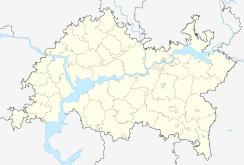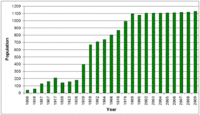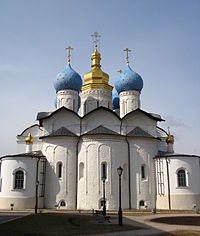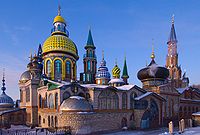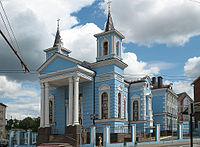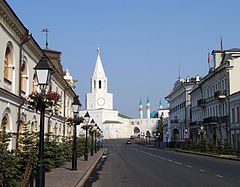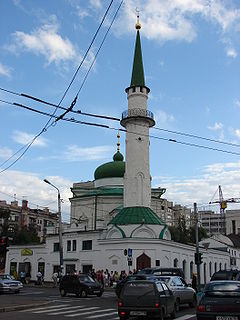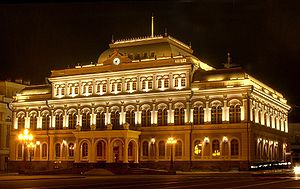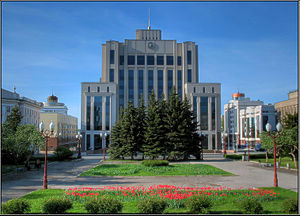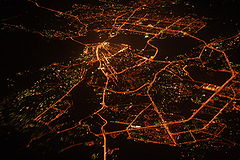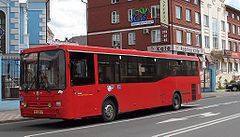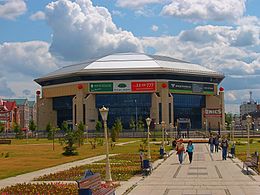- Kazan
-
This article is about the capital city of Tatarstan. For other uses, see Kazan (disambiguation).
Kazan (English)
Казань (Russian)
Казан (Tatar)- City[1] -
City of republic significance[1]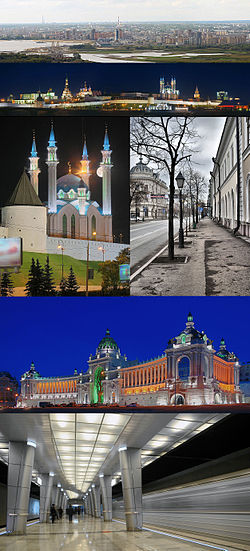
Coordinates: 55°47′N 49°10′E / 55.783°N 49.167°ECoordinates: 55°47′N 49°10′E / 55.783°N 49.167°E Coat of arms Flag City Day August 30[2] Administrative status Country Russia Federal subject Republic of Tatarstan[3] Capital of Republic of Tatarstan[3] Municipal status Urban okrug Kazan Urban Okrug[citation needed] Mayor[3] Ilsur Metshin[3] Representative body City Duma[3] Statistics Area 425.3 km2 (164.2 sq mi)[4] Population (2010 Census,
preliminary)1,143,546 inhabitants[5] - Rank in 2010 8th Population (2002 Census) 1,105,289 inhabitants[6] - Rank in 2002 8th Density 2,689 /km2 (6,960 /sq mi)[7] Time zone MSD (UTC+04:00)[8] Founded ~1005[4] Postal code(s) 420xxx[9] Dialing code(s) +7 843[10] Official website Kazan (Russian: Каза́нь; Tatar Cyrillic: Казан, Latin: Qazan) is the capital and largest city of the Republic of Tatarstan, Russia. With a population of 1,143,546 (2010 Census preliminary results),[5] it is the eighth most populous city in Russia. Kazan lies at the confluence of the Volga and Kazanka Rivers in European Russia. In April 2009, the Russian Patent Office granted Kazan the right to brand itself as the "Third Capital" of Russia. In 2009 it was chosen as the "sports capital of Russia"[11] and it still is referred to as.[12] The Kazan Kremlin is a World Heritage Site.
Contents
History
Main article: Kazan historyEtymology
The origin of the name Kazan is uncertain. The most accepted legends derive it from the Bulgarian (and also modern Tatar) word qazan, which means 'boiler' or 'cauldron'.
Middle Ages
There is a long-running dispute as to whether Kazan was founded by the Muslim Volga Bulgars in the early Middle Ages or by the Tatars of the Golden Horde in the mid-15th century, as written records before the latter period are sparse. If there was a Bulgar city on the site, estimates of the date of its foundation range from the early 11th century to the late 13th century (see Iske Qazan). It was a border post between Volga Bulgaria and two Finnic tribes, the (Mari and the Udmurt). Another vexatious question is where the citadel was built originally. Archaeological explorations have produced evidence of urban settlement in three parts of the modern city: in the Kremlin; in Bişbalta at the site of the modern Zilantaw monastery; and near the Qaban lake. The oldest of these seems to be the Kremlin.
If Kazan existed in the 11th and 12th centuries, it could have been a stop on a Volga trade route from Scandinavia to Baghdad. It was a trade center, and possibly a major city for Bulgar settlers in the Kazan region, although their capital was further south at the city of Bolğar.
After the Mongols devastated the Bolğar and Bilär areas in the 13th century, migrants resettled Kazan. Kazan became a center of a duchy which was a dependency of the Golden Horde. Two centuries later, in the 1430s, Hordian Tatars (such as Ghiasetdin of Kazan) usurped power from its Bolghar dynasty.
Some Tatars also went to Lithuania, brought by Vytautas the Great.
In 1438, after the destruction of the Golden Horde, Kazan became the capital of the powerful Khanate of Kazan. The city bazaar, Taş Ayaq (Stone Leg)' became the most important trade center in the region, especially for furniture. The citadel and Bolaq channel were reconstructed, giving the city a strong defensive capacity. The Russians managed to occupy the city briefly several times.
Russian Tsardom times
As a result of the Siege of Kazan (1552) Russia under Ivan the Terrible conquered the city for good and the majority of the population was massacred. During the governorship of Alexander Gorbatyi-Shuisky, most of the khanates's Tatar residents were killed or forcibly Christianized. Mosques and palaces were ruined. The surviving Tatar population was moved to a place 50 kilometres (31 mi) away from the city and this place was forcibly settled by Russian farmers and soldiers. Tatars in the Russian service were settled in the Tatar Bistäse settlement near the city's wall. Later Tatar merchants and handicraft masters also settled there. During this period, Kazan was largely destroyed as a result of several great fires. After one of them in 1579, the icon Our Lady of Kazan was discovered in the city.
In the early 17th century, at the beginning of the Time of Troubles in Russia, the Tsardom of Kazan declared independence with the help of the Russian population, but this independence was suppressed by Kuzma Minin in 1612.[citation needed].
Russian Empire times
In 1708, the Tsardom of Kazan was abolished, and Kazan became the center of a guberniya. After Peter the Great's visit, the city became a center of shipbuilding for the Caspian fleet. The major Russian poet Gavrila Romanovich Derzhavin was born in Kazan in 1743, the son of a poor country squire of Tatar ancestry though himself having a thoroughly Russian identity. Kazan was largely destroyed in 1774 as a result of the Pugachev revolt, a revolt by border troops and peasants led by the Don Cossack ataman (captain) Yemelyan Pugachev, but was rebuilt soon afterwards, during the reign of Catherine the Great. Catherine also decreed that mosques could again be built in Kazan, the first being Marjani Mosque. In the beginning of the 19th century Kazan State University and printing press were founded by Alexander I. It became an important center for Oriental Studies in Russia. The Qur'an was first printed in Kazan in 1801. Kazan became an industrial center and peasants migrated there to join its industrial workforce. In 1875, a horse tramway appeared; 1899 saw the installation of a tramway. After the Russian Revolution of 1905, Tatars were allowed to revive Kazan as a Tatar cultural center. The first Tatar theater and the first Tatar newspaper appeared.
Soviet period
In 1917 Kazan became one of the revolution centers. In 1918, Kazan was a capital of the Idel-Ural State, which was suppressed by the Bolshevist government. In the Kazan Operation of August 1918, it was briefly occupied by Czechoslovak Legions. In 1920 (after the October Revolution), Kazan became the center of Tatar Autonomous Soviet Socialist Republic. In the 1920s and 1930s, most of the city's mosques and churches were destroyed, as occurred elsewhere in the USSR. During World War II, many industrial plants and factories to the west were relocated in Kazan, making the city a center of the military industry, producing tanks and planes. After the war Kazan consolidated as an industrial and scientific center. In 1979, the city's population reached one million.
Modern times
In the late 1980s and in the 1990s, after the dissolution of the USSR, Kazan again became the center of Tatar culture, and separatist tendencies intensified. With the return of the capitalism era Kazan became one the most important centers of the Russian Federation. The city came up from 10th to 6th position in population ranking of Russian cities. In the late 2000s the city earned the right to host both the 2013 Summer Universiade and 2018 FIFA World Cup.
Millennium of Kazan
Since 2000, the city has been undergoing a total renovation. The historical center, including its Kremlin, has been rebuilt. Kazan celebrated its millennium in 2005, after a city-organised historical commission settled on 1005 as the official year of the city's founding.[13] During the millennium celebrations, one of the largest mosque in Russia, Qolsharif, was dedicated in the Kazan Kremlin, the holiest copy of Our Lady of Kazan was returned to the city, the "Millennium Bridge" was inaugurated that year,[14] and Kazan Metro began operation.
Demographics
Ethnicity and religion
Main articles: Islam in Tatarstan and Kazan ethnic communitiesThe city's population consists mostly of ethnic Russians, circa 48.8 percent or Tatars circa 47.5 percent. The populace of Kazan includes Chuvash, Ukrainians, Azeri, and Jews.[15] Predominant faiths of Kazan city are Sunni Islam and Eastern Orthodoxy with Catholicism, Protestantism, Judaism, Krishnaism, and the Bahá'í Faith also counted among the faithful of Kazan.
Languages
Tatar and Russian languages are widely spoken in the city. Russian is understood by practically all the population, apart from some older Tatars. Tatar is widely spoken mainly by Tatars.
Population
Population: 1,143,600 (2010 Census preliminary results);[5] 1,105,289 (2002 Census);[6] 1,094,378 (1989 Census).[16]
Year Population 1550 50,000 1557 7,000 1800 40,000 1830 43,900 1839 51,600 1859 60,600 1862 63,100 1883 140,000 1897 130,000 1917 206,600 1926 179,000 1939 398,000 1959 667,000 1979 989,000 1989 1,094,378 (census) 1997 1,076,000 2000 1,089,500 2002 1,105,289 (census) 2008 1,120,200 2009 1,130,717 2010 1,143,600 (census) Climate
Kazan has a humid continental climate (Köppen climate classification Dfb) with long cold winters and warm, often hot dry summers. The warmest month is July with daily mean temperature near 20 °C (68 °F), coldest - January −12 °C (10 °F).
Climate data for Kazan Month Jan Feb Mar Apr May Jun Jul Aug Sep Oct Nov Dec Year Record high °C (°F) 3.8
(38.8)5.2
(41.4)11.0
(51.8)29.5
(85.1)33.8
(92.8)37.5
(99.5)38.9
(102.0)39.0
(102.2)32.3
(90.1)23.4
(74.1)15.0
(59.0)6.1
(43.0)39.0
(102.2)Average high °C (°F) −8.2
(17.2)−7.2
(19.0)−0.6
(30.9)9.8
(49.6)18.9
(66.0)23.5
(74.3)25.0
(77.0)22.4
(72.3)15.8
(60.4)7.2
(45.0)−1.5
(29.3)−5.7
(21.7)8.3 Average low °C (°F) −14.9
(5.2)−14
(6.8)−7.9
(17.8)1.4
(34.5)7.9
(46.2)13.1
(55.6)15.0
(59.0)12.8
(55.0)7.6
(45.7)1.4
(34.5)−6.3
(20.7)−11.6
(11.1)0.4 Record low °C (°F) −46.8
(−52.2)−39.9
(−39.8)−31.7
(−25.1)−25.6
(−14.1)−6.5
(20.3)−1.4
(29.5)2.6
(36.7)1.6
(34.9)−5.4
(22.3)−23.4
(−10.1)−36.6
(−33.9)−43.9
(−47.0)−46.8
(−52.2)Precipitation mm (inches) 35
(1.38)30
(1.18)25
(0.98)34
(1.34)38
(1.5)70
(2.76)66
(2.6)59
(2.32)55
(2.17)54
(2.13)44
(1.73)38
(1.5)548
(21.57)% humidity 83 81 79 71 58 66 70 71 76 81 87 85 75.7 Sunshine hours 49.6 89.6 148.8 204.0 273.0 294.0 291.4 254.2 159.0 83.7 42.0 34.1 1,923.4 Source no. 1: [17] Source no. 2: HKO Central Kazan
Kremlin
Main article: Kazan KremlinThe city has a citadel (Russian: кремль, tr. kreml', or sometimes Tatar: kirman), which was declared a World Heritage Site in 2000. Major monuments in the kremlin are the 5-domed 6-columned Annunciation Cathedral (1561–62) and the mysterious leaning Soyembika Tower, named after the last queen of Kazan and regarded as the city's most conspicuous landmark.
Also of interest are the towers and walls, erected in the 16th and 17th centuries but later reconstructed; the Qol-Şarif mosque, which is already rebuilt inside the citadel; remains of the Saviour Monastery (its splendid 16th-century cathedral having been demolished by the Bolsheviks) with the Spasskaya Tower; and the Governor's House (1843–53), designed by Konstantin Thon, now the Palace of the President of Tatarstan.
Next door, the ornate baroque Sts-Peter-and-Paul's Cathedral on Qawi Nacmi Street and Marcani mosque on Qayum Nasiri Street date back to the 18th century.
Bistä or Posad
Central Kazan is divided into two districts by the Bolaq canal and Lake Qaban. The first district (Qazan Bistäse or Kazanskiy Posad), historically Russian, is situated on the hill, the second (İske Tatar Bistäse or Staro-Tatarskaya Sloboda), historically Tatar, is situated between the Bolaq and the Volga. Mosques, such as Nurullah, Soltan, Bornay, Apanay, Äcem, Märcani, İske Taş, Zäñgär are in the Tatar district. Churches, such as Blagoveschenskaya, Varvarinskaya, Nikol'skaya, Tikhvinskaya, are mostly in the Russian part of the city. The main city-centre streets are Bauman, Kremlyovskaya, Dzerzhinsky, Tuqay, Puşkin, Butlerov, Gorkiy, Karl Marx and Märcani.
An old legend says that in 1552, before the Russian invasion, wealthy Tatars (baylar) hid gold and silver in Lake Qaban.
Wooden Kazan
In the beginning of 1990s most of Central Kazan was covered by wooden buildings, usually consisting of two floors. There was a historical environment of Kazan citizens, but not the best place to live in. During the Republican programme "The liquidation of ramshackle apartments" most of them (unlike other Russian cities), especially in Central Kazan, where the land is not cheap, were destroyed and their population was moved to new areas at the suburb of the city (Azino, Azino-2, Quartal 39). Nearly 100,000 citizens resettled by this programme.
Other major buildings
Another significant building in central Kazan is the former "Smolentzev and Shmelev" tea house and hotel, now the Shalyapin Palace Hotel. It is located at 7/80 Universitetskaya Street, at the corner of Universitetskaya and Bauman. A major landmark of late-19th and early-20th century commercial architecture, it consists of two portions. The original portion, built for a merchant named Usmanov in the 1860s, was bought by the inter-related families of Efim Smolentzev and Pavel and Nikolai Shmelev in 1899.[18] They operated a store selling, among other things, tea. In 1910, the Smolentevs and Shmelevs constructed another portion, designed by architect Vasili Trifonov, and operated a hotel there.[19] After the Russian Revolution, the building eventually became the Hotel Soviet and after 2000 it was heavily renovated to reopen as the Shalyapin Palace Hotel.
Cityscape


A panoramic view of Kazan Kremlin, Vernicle temple and Kazanka river right bank 

Kazanka right bank Education and science
Primary and secondary education
Primary and secondary education system of Kazan includes:
- 282 nurseries, most of which are municipal
- 178 schools, 2 of which are private
- 28 vocational technical schools
- 15 colleges
- 10 special colleges
There are also 49 music schools, 10 fine-arts schools and 43 sports schools.
Higher education
See also: List of Kazan UniversitiesThere are 44 institutes of higher education in Kazan, including 19 branches of universities from other cities. More than 140 000 students are educated in the city. Kazan Federal University (founded in 1804) is third oldest university in Russia after Saint Petersburg State University (1724) and Moscow State University (1755). In 2009 KFU got Federal status as main university of Volga Region. Some other prominent universities are:
- Kazan State Technical University - founded in 1932. In 2009 it got status of National university;
- Kazan State Medical University - founded in 1814 as a department within Kazan State University;
- Kazan State Technological University - founded in 1919 on the base of pre-existing vocational school;
- Kazan State Conservatory - founded in 1945;
Science
Kazan is a major scientific centre in Russia. Kazan formed a big number of scientific areas and schools (mathematical, chemical, medical, linguistic, geological, geobotanical, etc.). It is subject of special pride: the creation of non-Euclidean geometry (Nikolai Lobachevsky), the discovery of the chemical element ruthenium (Claus), the theory about the structure of organic compounds (Aleksandr Butlerov), the discovery of the electron paramagnetic resonance (Yevgeny Zavoisky) and acoustic paramagnetic resonance (Altshuler) and many others. City hosts:
- Kazan Science Centre of Russian Academy of Sciences, since 1945. It includes 5 academical institutions.
- Tatarstan Academy of Sciences, since 1991. It includes 7 local departments with 13 academical institutions (also, 21 organisations are under the guidance of TAS) and one branch in Ulyanovsk.[20]
Government and administration
Administrative division
Kazan is divided into seven districts:
No. District Population[5] Area (km²)[citation needed] 1 Aviastroitelny 113,371 38.91 2 Vakhitovsky 86,235 25.82 3 Kirovsky 109,066 108.79 4 Moskovsky 130,424 38.81 5 Novo-Savinovsky 203,038 20.66 6 Privolzhsky 227,841 115.77 7 Sovetsky 275,571 167.00 Mayor
See also: List of Kazan mayorsMayor is the head of the city. İlsur Metşin has been the mayor of Kazan since November 17, 2005
City Duma
Kazan City Duma is a representative body of the city, elected every four years.
Executive committee
Executive committee is a municipal body of the executive organs. Committee's head is Alexey Pesoshin.
Tatarstan government
Kazan hosts Tatarstan President's residence and administration (in Kremlin), Tatarstan's Cabinet of Ministers and Council of State (on Freedom square).
Economy
Main article: Economy of KazanKazan is one of the largest industrial and financial centres of Russia, and a leading city of the Volga economic region in construction and accumulated investment.[21] City's Gross Regional Product had reached 306 bln roubles (~$10 bln) in 2010.[22]
Total banking capital of Kazan banks is third in Russia.[23] The main industries of the city are: mechanical engineering, chemical, petrochemical, light and food industries. An innovative economy is represented by the largest IT-park in Russia which is one of the largest of its kind amongst Eastern Europe science parks.[24][25] Kazan ranks 174th (highest in Russia) in Mercer’s Worldwide Quality of Living Survey.[26]
Transport
Kazan International Airport
 "Prospect Pobedy" metro station
"Prospect Pobedy" metro station
Kazan International Airport is located 26 kilometers from the city centre. It is a hub for Tatarstan Airlines and Kazan Air Enterprise and hosts 11 air companies. Airport is connected with city by bus route #97. There is also the Kazan Borisoglebskoye airfield, home to Kazan Aircraft Production Association, a major aircraft factory, famous in the past as "Aircraft Plant 22" ("22nd Zavod"). Adjacent to it lies huge aircraft engines plant ("16th Zavod"). Currently it produces versions of Tupolev 204 and 214 aircraft, rather unsuccessful version of Boeing 757 single-aisle aircraft. In the past an Ilyushin-62, four-engine Russian mainliner, Typolev-160 "Black Jack" supersonic strategic bomber and Tu-22M tactic bomber were also produced here. Both these plants and adjacent workers' housing make a whole city district known as "Aviastroitelny" ("Aircraft Builders").
Railways
Kazan is connected with Moscow, Ulyanovsk, Yoshkar-Ola and Yekaterinburg by railways.
Main railway station "Kazan passazhirsky" is located in the city centre and includes main building (built in 1896), commuter trains terminal, ticket office building and some other technical buildings. Station serves 36 intercity trains and more than 8 million passengers per annum.[27]
There is a second terminal in the northern part of city, it serves only one intercity train. Reconstruction of the Northern terminal has been frozen.
Kazan city has also 19 platforms for commuter trains
Riverside station
Station serves intercity ships and commuter boats. Pneumocushion boats are used in winter time. Daily passenger turnover reaches 6 thousands.
Bus station
There are two bus stations in Kazan — Central and Southern. Bus routes connect Kazan with all districts of Tatarstan, Samara, Ufa, Tolyatti, Orenburg, Ulyanovsk, Cheboksary, Sterlitamak, Buzuluk, Baki and Aktobe. It is planned to build new stations in the East, West and North districts instead of Central for relieving city centre.
Highways
There are federal highway connections to Moscow and Ufa (E-22), Orenburg (R-239), Ul'yanovsk (R-241) and Igra (R-242). There are also R-175 federal highway and «Northern Europe — Western China» (in construction) route near the city.
There are five bridges across the Kazanka (Qazansu) river in the city, and one bridge connecting Kazan with the opposite bank of the Volga.
Public transit
- A single-line Kazan Metro, the north-southeast Central Line, opened on 27 August 2005. The Kazan Metro has seven stations, but there are plans to extend the line in both directions and is due to cross the Kazanka river with the stations "Dekabristov", "Moskovskaya", "Aviastroitel`naya" in 2012. Single trip costs 13-15 rub.
- The Kazan tram system was founded in 1899. 8 routes use 187 km (116.20 mi) of lines and 197 tramcars.[28] Single trip costs 10-12 rub. Rolling stock: LM-99, 71-608, 71-605.
- The Kazan trolleybus (electric bus) system was founded in 1948. 355 km (220.59 mi) of lines are used for 14 routes.[29] Single trip costs 13-15 rub. Vehicles: ZIU-682, Trolza-5275-05 "Optima", VMZ-5298.01-50 "Avangard".
- The Kazan bus system was totally renovated in 2007. 91 routes have an aggregate length of 1981 km. All 1444 buses are colored red. Single trip costs 16-18 rub. Unlike in most Western cities, public bus routes are not municipal, operated by private companies and therefore are very efficient. Most of buses are imported, produced by "Golden Dragon", "Higer", "NefAZ", "MAZ", "Yutong", "Hyundai", "Bogdan"
Sports
Men's teams:
- Ice hockey (KHL) - Ak Bars Kazan (2-time KHL champions; 4-time champion; 2007 IIHF European Champions Cup & 2008 IIHF Continental Cup winner)
- Football (Russian Premier League) - FC Rubin Kazan (2-time champion)
- Basketball (Russian Basketball Super League) - UNICS Kazan (2-time Cup holder; 2004 FIBA Europe League winner; 2011 Eurocup winner)
- Volleyball (Russian Superleague) - VC Zenit Kazan (3-time champion; 2008 CEV Champions League winner)
- Water polo (Higher League) - Sintez (2007 champion; 2005 Cup holder; 2007 LEN Cup winner)
- Bandy (Higher League) - Dynamo[30] (2009 Russian Cup holder,[31] 2009 FIB Champions Cup winner, 2010 Bandy World Cup winner)
- Rugby (Russian League) - Strela (6-time champion)
- Field hockey (Russian League) - Dinamo (5-time champion)
- Team handball - KAI-Zilant (dissolved in 2008);
- Futsal - Privolzhanin (dissolved in 2004);
Famous athletes
- Alexander Burmistrov - Hockey player (NHL; Winnipeg Jets, Atlanta Thrashers; OHL; Barrie Colts)
- Viktor Kolotov - football player
- Ruslan Nigmatullin - football player
- Denis Arkhipov - hockey player
- Svetlana Demina - sport shooter
Infrastructure
- Central stadium - olympic stadium, capacity 30,133. Home ground for FC «Rubin». Also, new football arena with capacity 45,000 is under construction and has to be ready in 2012-2013.
- TatNeft Arena - indoor sporting arena, capacity 10,000. Home to HSC «Aq Bars»
- Basket-Hall - indoor sporting arena, capacity 7,000 (large hall) and 1,500 (small hall). Home to BC «UNICS»
- «Rubin» stadium, capacity 10,000. Home to FC «Rubin-2»
- Volleyball center, capacity 4,600. Home to VC «Zenit» and WVC «Dynamo-Kazan»
- Field Hockey centre, capacity 2,700.
- «Raketa» and «Trudovye Rezervy» ice stadiums
Important events
- Kazan is the host city for the 2013 Summer Universiade, 2015 World Aquatics Championships, 2017 FIFA Confederations Cup and 2018 FIFA World Cup.
- 2011 European Weightlifting Championships
- 2005 and 2011 Bandy World Championships
- 2010 finswimming European championship
- 2008 ice hockey juniors world championship
- 2008 boxing students world championship
- 2007 field hockey Europe championship
International relations
Branch Offices of Embassies
Consulates
Two consulates general are found in Kazan.[33]
Visa centers
 Italian Visa Center in Kazan.[34]
Italian Visa Center in Kazan.[34] Joint Visa Application Center of European Union for:
Joint Visa Application Center of European Union for:
Twin towns/sister cities
 Al Qalyubiyah (Egypt), since 2001
Al Qalyubiyah (Egypt), since 2001 Al Minufiyah (Egypt), since 1997
Al Minufiyah (Egypt), since 1997 Antalya (Turkey), since 2003
Antalya (Turkey), since 2003 Astana (Kazakhstan), since 2004
Astana (Kazakhstan), since 2004 Braunschweig (Germany), since 1988
Braunschweig (Germany), since 1988 College Station, Texas (USA), since 1990
College Station, Texas (USA), since 1990
Kazan has also partner relations with the following cities and regions:
 Almaty (Kazakhstan), since 1996
Almaty (Kazakhstan), since 1996 Arkhangelsk (Russia), since 1999
Arkhangelsk (Russia), since 1999 Astrakhan (Russia), since 1997
Astrakhan (Russia), since 1997 Baku (Azerbaijan), since 2003
Baku (Azerbaijan), since 2003 Bishkek (Kyrgyzstan), since 1998
Bishkek (Kyrgyzstan), since 1998 Chelyabinsk (Russia), since 2002
Chelyabinsk (Russia), since 2002 Evpatoria (Ukraine), since 1998
Evpatoria (Ukraine), since 1998 Ivanovo (Russia), since 1997
Ivanovo (Russia), since 1997 Jūrmala (Latvia), since 2002
Jūrmala (Latvia), since 2002 Kabul (Afghanistan), since 2005
Kabul (Afghanistan), since 2005 Krasnoyarsk (Russia), since 2001
Krasnoyarsk (Russia), since 2001 Nizhny Novgorod (Russia), since 1997
Nizhny Novgorod (Russia), since 1997 Oryol (Russia), since 2010
Oryol (Russia), since 2010
 Orenburg (Russia), since 2001
Orenburg (Russia), since 2001 Samara (Russia), since 1998
Samara (Russia), since 1998 Saratov (Russia), since 1999
Saratov (Russia), since 1999 Shumen Province (Bulgaria), since 2003
Shumen Province (Bulgaria), since 2003 Tashkent (Uzbekistan), since 1998
Tashkent (Uzbekistan), since 1998 Ufa (Russia), since 1999
Ufa (Russia), since 1999 Ulan-Ude (Russia), since 2003
Ulan-Ude (Russia), since 2003 Ulyanovsk (Russia), since 1998
Ulyanovsk (Russia), since 1998 Urbino (Italy), since 2001
Urbino (Italy), since 2001 Volgograd (Russia), since 2005
Volgograd (Russia), since 2005 Yaroslavl (Russia), since 2003
Yaroslavl (Russia), since 2003 Yoshkar-Ola (Russia), since 2002
Yoshkar-Ola (Russia), since 2002
International organisations membership
- Organization of World Heritage Cities
- United Cities and Local Governments
- Twin Cities International Association
- Historic Cities International Association
- General Conference of Mayors for Peace
Kazan has an Alliance française centre.
Kazan has an American Corner.[2]
References
Notes
- ^ a b Order #01-02/34, Section 2
- ^ http://kgmu.kcn.ru/english/about_kazan.html
- ^ a b c d e The city of Kazan official portal
- ^ a b Investment Passport of Kazan
- ^ a b c d Федеральная служба государственной статистики (Federal State Statistics Service) (2011). "Предварительные итоги Всероссийской переписи населения 2010 года (Preliminary results of the 2010 All-Russian Population Census)" (in Russian). Всероссийская перепись населения 2010 года (All-Russia Population Census of 2010). Federal State Statistics Service. http://www.perepis-2010.ru/results_of_the_census/results-inform.php. Retrieved 2011-04-25.
- ^ a b Федеральная служба государственной статистики (Federal State Statistics Service) (2004-05-21). "Численность населения России, субъектов Российской Федерации в составе федеральных округов, районов, городских поселений, сельских населённых пунктов – районных центров и сельских населённых пунктов с населением 3 тысячи и более человек (Population of Russia, its federal districts, federal subjects, districts, urban localities, rural localities—administrative centers, and rural localities with population of over 3,000)" (in Russian). Всероссийская перепись населения 2002 года (All-Russia Population Census of 2002). Federal State Statistics Service. http://www.perepis2002.ru/ct/doc/1_TOM_01_04.xls. Retrieved 2010-03-23.
- ^ The value of density was calculated automatically by dividing the 2010 Census population by the area specified in the infobox. Please note that this value may not be accurate as the area specified in the infobox does not necessarily correspond to the area of the entity proper or is reported for the same year as the population.
- ^ Правительство Российской Федерации. Постановление №725 от 31 августа 2011 г. «О составе территорий, образующих каждую часовую зону, и порядке исчисления времени в часовых зонах, а также о признании утратившими силу отдельных Постановлений Правительства Российской Федерации». Вступил в силу по истечении 7 дней после дня официального опубликования. Опубликован: "Российская Газета", №197, 6 сентября 2011 г. (Government of the Russian Federation. Resolution #725 of August 31, 2011 On the Composition of the Territories Included into Each Time Zone and on the Procedures of Timekeeping in the Time Zones, as Well as on Abrogation of Several Resolutions of the Government of the Russian Federation. Effective as of after 7 days following the day of the official publication).
- ^ Kazan Russia — a thousand-year Russian city
- ^ Current local time in Kazan
- ^ Komsomolskaya Pravda: Kazan - sports capital of Russia 14.12.2009
- ^ http://www.mytopdozen.com/Best_Tatars.html
- ^ Шаймиев, Минтимер Шарипович; Камиль Исхаков, Мансур Х Хәсәнов (1999). "Выступления Президента РТ М.Шаймиева, мэра г.Казани К.Исхакова и президента АН РТ, академика М.Хасанова на торжественном собрании по случаю установления даты основания г.Казани. 10 сентября 1999 года". Гасырлар авазы / Эхо веков (3/4). http://www.archive.gov.tatarstan.ru/magazine/go/anonymous/main/?path=mg:/numbers/1999_3_4/01/01_2/. Retrieved 2011-07-17.
- ^ Putin joins Tatarstan festivities BBC News 2005-08-26
- ^ (RUS) НОВЫЙ ОБЛИК КАЗАНИ
- ^ "Всесоюзная перепись населения 1989 г. Численность наличного населения союзных и автономных республик, автономных областей и округов, краёв, областей, районов, городских поселений и сёл-райцентров. (All Union Population Census of 1989. Present population of union and autonomous republics, autonomous oblasts and okrugs, krais, oblasts, districts, urban settlements, and villages serving as district administrative centers.)" (in Russian). Всесоюзная перепись населения 1989 года (All-Union Population Census of 1989). Demoscope Weekly (website of the Institute of Demographics of the State University—Higher School of Economics. 1989. http://demoscope.ru/weekly/ssp/rus89_reg.php. Retrieved 2010-03-23.
- ^ "Pogoda.ru.net" (in Russian). July 2011. http://pogoda.ru.net/climate/27595.htm. Retrieved 2009-03-22.
- ^ "ИЗДАНИЯ ЦБС "Прогулки по городу"". http://www.cbs-kazan.ru/izdania-progulki-baumana3.htm. Retrieved 2008-02-20.
- ^ "До тысячелетия Казани осталось 36 дней. Гостиница "Совет"". http://info.tatcenter.ru/photo/29350.htm. Retrieved 2008-02-20.
- ^ Структура АНРТ
- ^ Основные социально-экономические показатели городов 2008
- ^ [1]
- ^ Расстановка точек над столицами
- ^ В строительство IT-парка вложили 3 миллиарда
- ^ Инновационный технопарк Идея
- ^ NZ cities excel in quality of living - Mercer worldwide survey finds
- ^ ГЖД в 2006 году больше всего пассажиров отправила со станции Горький-Московский
- ^ Выступление А. К. Абдулхакова на аппаратном совещании 09.02.2009 «Об итогах работы городского пассажирского транспорта за 2008 год»
- ^ В 2008 году в Казани всеми видами городского транспорта перевезено 319,9 млн пассажиров
- ^ http://www.dinamo-kazan.ru/
- ^ Video from their 1st Russian Cup victory against Yenisey from Krasnoyarsk in the final. http://bandynet.ru/node/7273
- ^ Embassy of Belarus
- ^ Offices in Kazan
- ^ Visa Management Service. Filiali
- ^ Embassy of Finland
- ^ Kazan City Committee for external relations and tourism
Sources
- Министерство юстиции Республики Татарстан. Приказ №01-02/34 от 20 мая 2010 г. «Об утверждении реестра административно-территориальных единиц Республики Татарстан», в ред. Приказа №01-02/53 от 10 августа 2010 г «О внесении изменений в Приказ Министерства юстиции Республики Татарстан от 20.05.2010 №01-02/34 "Об утверждении реестра административно-территориальных единиц Республики Татарстан"». Опубликован: "Республика Татарстан", №116 (Приказ), 8 июня 2010 г. (Ministry of Justice of the Republic of Tatarstan. Order #01-02/34 of May 20, 2010 On the Adoption of the Registry of the Administrative-Territorial Units of the Republic of Tatarstan, as amended by the Order #01-02/53 of August 10, 2010 On Amending the Order of the Ministry of Justice of the Republic of Tatarstan of May 20, 2010 No. 01-02/34 "On the Adoption of the Registry of the Administrative-Territorial Units of the Republic of Tatarstan". ).
- Álvarez Veinguer, Aurora (July 2007). "(Re)Presenting Identities: National Archipelagos in Kazan". Nationalities Papers 35 (3): 457–476. doi:10.1080/00905990701368704.
External links
- (English) Virtual Guide around Kazan for tourists
- (English) Kazan city tourist portal
- (English) The City of Kazan
- (English) Kazan millenium
- (English) Universiade Kazan 2013
- Kazan 1000 years old
- The history of Islamic religion in Kazan
- Kazan - Global Stroll
- Images of the Kazan Kremlin and famous Mosque Interactive Google Maps Kazan Kremlin
- http://www.kazan-memory.uni-tuebingen.de/indexee.html - Student project about Kazan's history (central aspects: memory, religion)
- map of Kazan
- The architecture of Kazan (in rus)
- Russia - Republic of Tatarstan - Kazan - photo galleries
Administrative divisions of the Republic of Tatarstan Capital: Kazan
Cities and towns Agryz · Almetyevsk · Arsk · Aznakayevo · Bavly · Bolgar · Bugulma · Buinsk · Chistopol · Laishevo · Leninogorsk · Mamadysh · Mendeleyevsk · Menzelinsk · Naberezhnye Chelny · Nizhnekamsk · Nurlat · Tetyushi · Yelabuga · Zainsk · Zelenodolsk
Administrative districts Agryzsky · Aksubayevsky · Aktanyshsky · Alexeyevsky · Alkeyevsky · Almetyevsky · Apastovsky · Arsky · Atninsky · Aznakayevsky · Baltasinsky · Bavlinsky · Bugulminsky · Buinsky · Cheremshansky · Chistopolsky · Drozhzhanovsky · Kamsko-Ustyinsky · Kaybitsky · Kukmorsky · Laishevsky · Leninogorsky · Mamadyshsky · Mendeleyevsky · Menzelinsky · Muslyumovsky · Nizhnekamsky · Novosheshminsky · Nurlatsky · Pestrechinsky · Rybno-Slobodsky · Sabinsky · Sarmanovsky · Spassky · Tetyushsky · Tukayevsky · Tyulyachinsky · Verkhneuslonsky · Vysokogorsky · Yelabuzhsky · Yutazinsky · Zainsky · ZelenodolskyCapitals of the Republics of Russia Categories:- Capitals of republics of Russia
- Kazan
- Populated places on the Volga
- Populated places established in the 11th century
Wikimedia Foundation. 2010.

